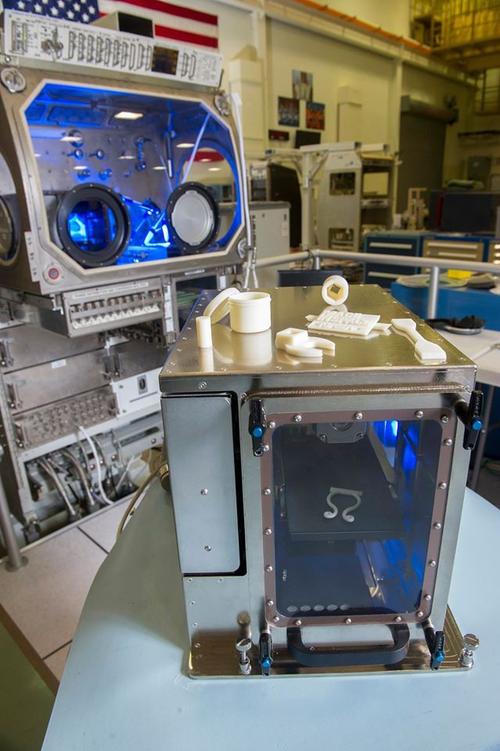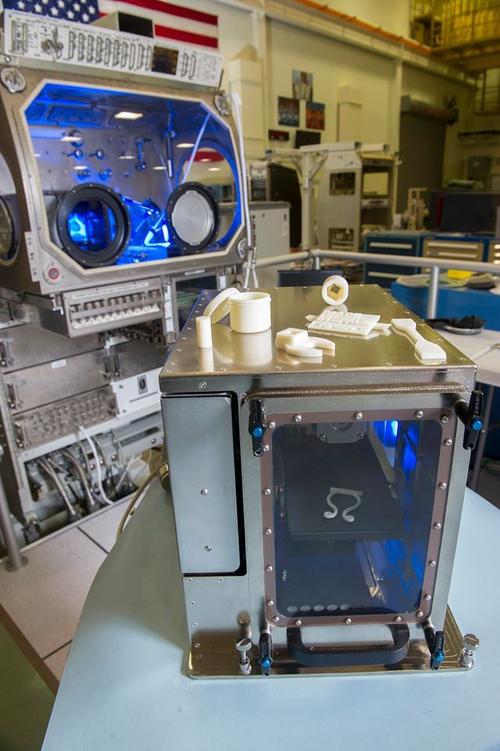In Space, a 3D Printer Beats Duct Tape Every Time
May 26, 2015

Made In Space is on a mission to change the way space exploration is done by changing how things are manufactured in, and for, outer space. That's been true since the company was founded in 2010. In his keynote address at the RAPID 2015 conference last week, CTO Jason Dunn gave an update on how far they and co-development partner NASA have come in their quest to bring 3D printing (3DP) to the space station -- and beyond.
The company made history with NASA last year when it sent the first 3D printer to the space station, and again when the first print samples came back in February for testing, which is ongoing. Those samples included real parts and a wide range of test coupons, such as tensile, flexure, and range, Dunn said. Most of them were produced to see exactly how difficult it is to print objects in space compared to printing the same objects on Earth. The company's first printer had been tested extensively in micro-G, but space is a different environment.
The aim is to produce usable stuff in space like tools and replacement parts, without the huge supply chain problem NASA currently has. How huge? How about $10,000 just to get a liter of bottled water to the International Space Station (ISS)? That's the example Dunn gave to illustrate the problem Made In Space wants to solve. That mind boggling figure is mostly the result of using old, inefficient chemical propulsion technology, he said. "Any other technology that's this inefficient would be ripe for disruption." The effect is that, when we go into space today, we pack like we do for a camping trip: bring everything we could possibly need, and when we run into trouble, call home for help. "Everything we build is built to survive launch: it's over-engineered," he said. "But what if everything could be built in space, so nothing had to be launched?"
Right now, astronauts on the ISS use Duct tape and available objects lying around like a used toothbrush and a spare metal bracket to MacGyver solutions to minor problems they encounter. Someday soon, though, they'll be able to print what they need by utilizing in-situ resources such as plastics recycled into new filament. "In space, a 3D printer is more useful than Duct tape," Dunn said. To that end, Made in Space is also developing a materials recycler, the R3DO, for reusing 3D-printed objects.

Discussions of how to improve the space supply chain problem usually focus on getting supplies to astronauts faster. But another way to shrink the chain is to reduce the distance between source and destination, said Dunn. That could be achieved with 3D printing using in situ resources, whether that's moon dust or recycled plastics.
Printing everything they need would also help cut back on the trash problem up there, which is severe. In the small, cramped, entirely enclosed environment of the space station, trash accumulates until the next resupply -- and garbage disposal -- mission arrives to take it away.
MORE FROM DESIGN NEWS: Students: NASA Wants You to Design Its Next Space Tool
Astronauts will also eventually be 3D printing objects made of metal. Although the first samples printed on the ISS are all plastic, Dunn said Made In Space has studied several processes and materials for producing composites and metals with its 3D printer. Instead of processes that use powder metals, they're focusing on methods that use solid metal.
But it's not just space station astronauts who will benefit from 3D printing objects in space. Dunn said the Zero-G 3D printer will also be available for use by various groups conducting experiments on the ISS. Also, as we've reported, building large structures in space via robotics plus 3D printing could reduce the cost and risk of building systems and then launching them into orbit. Structures can also be made that are bigger and more fragile than is now possible on Earth, but which would be perfect for the zero-gravity environment of space.
MORE FROM DESIGN NEWS: Update: NASA 3D Printer for Space Passes First Tests
Made In Space is now building the second version of its Zero-G 3D printer, which will be shipped to the ISS later this year, said Dunn. This version will also be remotely operated, and will incorporate lessons learned from the first one. Among other features, it will be able to withstand up to 9Gs and provide verification inside the printer. The team is also working on a permanent facility for housing the printer on the ISS.
Ann R. Thryft is senior technical editor, materials & assembly, for Design News. She's been writing about manufacturing- and electronics-related technologies for 27 years, covering manufacturing materials & processes, alternative energy, machine vision, and all kinds of communications.
Atlantic Design & Manufacturing, the largest advanced design and manufacturing trade show serving the Northeastern US, will take place in New York, June 9-11, 2015. It's your chance to meet qualified suppliers, get hands-on with the latest technologies, and expand your network. Learn more here.
About the Author(s)
You May Also Like



